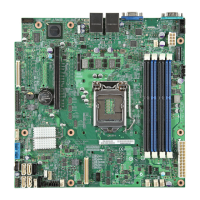Platform Management Functional Overview Intel® Server Board S1200V3RP TPS
Revision 1.2
See Appendix B – Integrated BMC Sensor Tables for additional sensor information.
6.8 Field Replaceable Unit (FRU) Inventory Device
The BMC implements the interface for logical FRU inventory devices as specified in the
Intelligent Platform Management Interface Specification, Version 2.0. This functionality provides
commands used for accessing and managing the FRU inventory information. These commands
can be delivered through all interfaces.
The BMC provides FRU device command access to its own FRU device and to the FRU
devices throughout the server. The FRU device ID mapping is defined in the Platform Specific
Information. The BMC controls the mapping of the FRU device ID to the physical device.
6.9 System Event Log (SEL)
The BMC implements the system event log as specified in the Intelligent Platform Management
Interface Specification, Version 2.0. The SEL is accessible regardless of the system power state
through the BMC's in-band and out-of-band interfaces.
The BMC allocates 65,502 bytes (approximately 64 KB) of non-volatile storage space to store
system events. The SEL timestamps may not be in order. Up to 3,639 SEL records can be
stored at a time. Any command that results in an overflow of the SEL beyond the allocated
space is rejected with an Out of Space IPMI completion code (C4h).
Events logged to the SEL can be viewed using Intel’s SELVIEW utility, Embedded Web Server,
and Active System Console.
6.10 System Fan Management
The BMC controls and monitors the system fans. Each fan is associated with a fan speed
sensor that detects fan failure and may also be associated with a fan presence sensor for hot-
swap support. For redundant fan configurations, the fan failure and presence status determines
the fan redundancy sensor state.
The system fans are divided into fan domains, each of which has a separate fan speed control
signal and a separate configurable fan control policy. A fan domain can have a set of
temperature and fan sensors associated with it. These are used to determine the current fan
domain state.
A fan domain has three states: sleep, nominal, and boost. The sleep and boost states have
fixed (but configurable through OEM SDRs) fan speeds associated with them. The nominal
state has a variable speed determined by the fan domain policy. An OEM SDR record is used to
configure the fan domain policy.
System fan speeds are controlled through pulse width modulation (PWM) signals, which are
driven separately for each domain by integrated PWM hardware. Fan speed is changed by
adjusting the duty cycle, which is the percentage of time the signal is driven high in each pulse.
6.10.1 Thermal and Acoustic Management
This feature refers to enhanced fan management to keep the system optimally cooled while
reducing the amount of noise generated by the system fans. Aggressive acoustics standards

